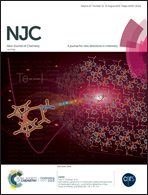Antimicrobial activities of self-assembled copper(ii), nickel(ii), and cobalt(iii) complexes combined with crystallographic, spectroscopic, DFT calculations and Hirshfeld surfaces analyses†
Abstract
The quinazoline-type ligand 2-(4-methoxy-2-hydroxyphenyl)-4-methyl-1,2-dihydroquinazolin 3-oxide (HL1, H is the deprotonatable hydrogen) was synthesized. [Cu(L2)]·CH3OH (1), [Ni(L2)2] (2), and [Co(L2)2](NO3) (3) (HL2 = 1-(2-{[(E)-(4-methoxy-2-hydroxybenzylidene]amino}phenyl)ethanone oxime) were obtained by reaction of an amount of HL1 with different metal salts in methanol. All of the synthesized compounds were characterized by elemental analyses and spectroscopic methods. The structures of the complexes were confirmed by single-crystal X-ray crystallography and was revealed that 1 had 1 : 1 whereas 2 and 3 had 2 : 1 ligand-to-metal ratios. In the crystal structures, penta-coordinated Cu(II) complex 1 formed an infinite 1-D, 2-D and 3-D supramolecular structure; hexa-coordinated Ni(II) complex 2 possessed interesting W-shaped 2-D network and even X-shaped 3-D layer skeleton; six-coordinated Co(III) complex 3 had one free nitrate anion and assembled into 2-D and 3-D supramolecular frameworks. Furthermore, the antimicrobial activities of all compounds were tested. Density functional theory (DFT) calculations were executed to ascertain the optimum geometry structures of all complexes. The noncovalent interactions among three complexes were quantified with Hirshfeld surfaces using CrystalExplorer.



 Please wait while we load your content...
Please wait while we load your content...